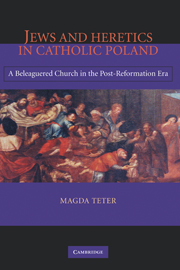Book contents
- Frontmatter
- Contents
- List of Illustrations
- Preface and Acknowledgments
- Note on Terms, Spelling, and Translations
- Abbreviations
- JEWS AND HERETICS IN CATHOLIC POLAND
- Introduction
- 1 “One Mystical Body … Only One Shepherd”: The Church Ideals of Social Order
- 2 The Upset Social Order: Nobles and the Jews in Poland
- 3 Heresy and the Fleeting “Triumph of the Counter-Reformation”
- 4 “Bad and Cruel Catholics”: Christian Sins and Social Intimacies Between Jews and Christians
- 5 “A Shameful Offence”: The Nobles and Their Jews
- 6 “Countless Books Against Common Faith”: Catholic Insularity and Anti-Jewish Polemic
- 7 “Warding Off Heretical Depravity”: “Whom Does the Catholic Church Reject, Condemn and Curse?”
- Conclusion: Did the Counter-Reformation Triumph in Poland?
- Glossary
- Notes
- Selected Bibliography
- Index
2 - The Upset Social Order: Nobles and the Jews in Poland
Published online by Cambridge University Press: 12 January 2010
- Frontmatter
- Contents
- List of Illustrations
- Preface and Acknowledgments
- Note on Terms, Spelling, and Translations
- Abbreviations
- JEWS AND HERETICS IN CATHOLIC POLAND
- Introduction
- 1 “One Mystical Body … Only One Shepherd”: The Church Ideals of Social Order
- 2 The Upset Social Order: Nobles and the Jews in Poland
- 3 Heresy and the Fleeting “Triumph of the Counter-Reformation”
- 4 “Bad and Cruel Catholics”: Christian Sins and Social Intimacies Between Jews and Christians
- 5 “A Shameful Offence”: The Nobles and Their Jews
- 6 “Countless Books Against Common Faith”: Catholic Insularity and Anti-Jewish Polemic
- 7 “Warding Off Heretical Depravity”: “Whom Does the Catholic Church Reject, Condemn and Curse?”
- Conclusion: Did the Counter-Reformation Triumph in Poland?
- Glossary
- Notes
- Selected Bibliography
- Index
Summary
In early modern poland, catholic church officials did not aspire to the kind of actual political power held by the Church in the Papal States. They seem to have continued to accept the medieval ideal of Church hierocracy, by which the Church would work together with temporal authorities in the expectation that the temporal powers themselves would act for the good of the Church and “at the will and sufferance of the priest.” As late as the eighteenth century, the principle of the two swords of spiritual and temporal powers was still, it seems, of considerable importance in Poland, as the title of the 1731 book by Józef Andrzej Załuski, Two Swords of Catholic Retaliation against Unrelenting Attacks of Polish Dissidents in the Orthodox Catholic Kingdom, suggests.
In 1733, after the death of King August II, Bishop Jan Felix Szaniawski urged in a sermon: “Let us plead with God that he will place [the crown] on the head of the one who is able to maintain the Catholic Faith, our Laws and Freedoms, and is able to preserve the Unity of the Kingdom.” And in 1753, a preacher, Adam Abramowicz, came close to repeating the idea embodied in bull Unam Sanctam: “In the Church of Christ, there is, and has to be, only one highest and visible Shepherd…. And just as there is only one shepherd, there is and has to be only one fold of Christ, outside of which no one will achieve redemption.
- Type
- Chapter
- Information
- Jews and Heretics in Catholic PolandA Beleaguered Church in the Post-Reformation Era, pp. 21 - 40Publisher: Cambridge University PressPrint publication year: 2005



